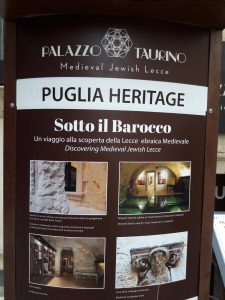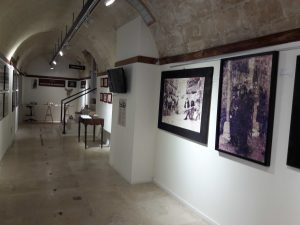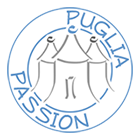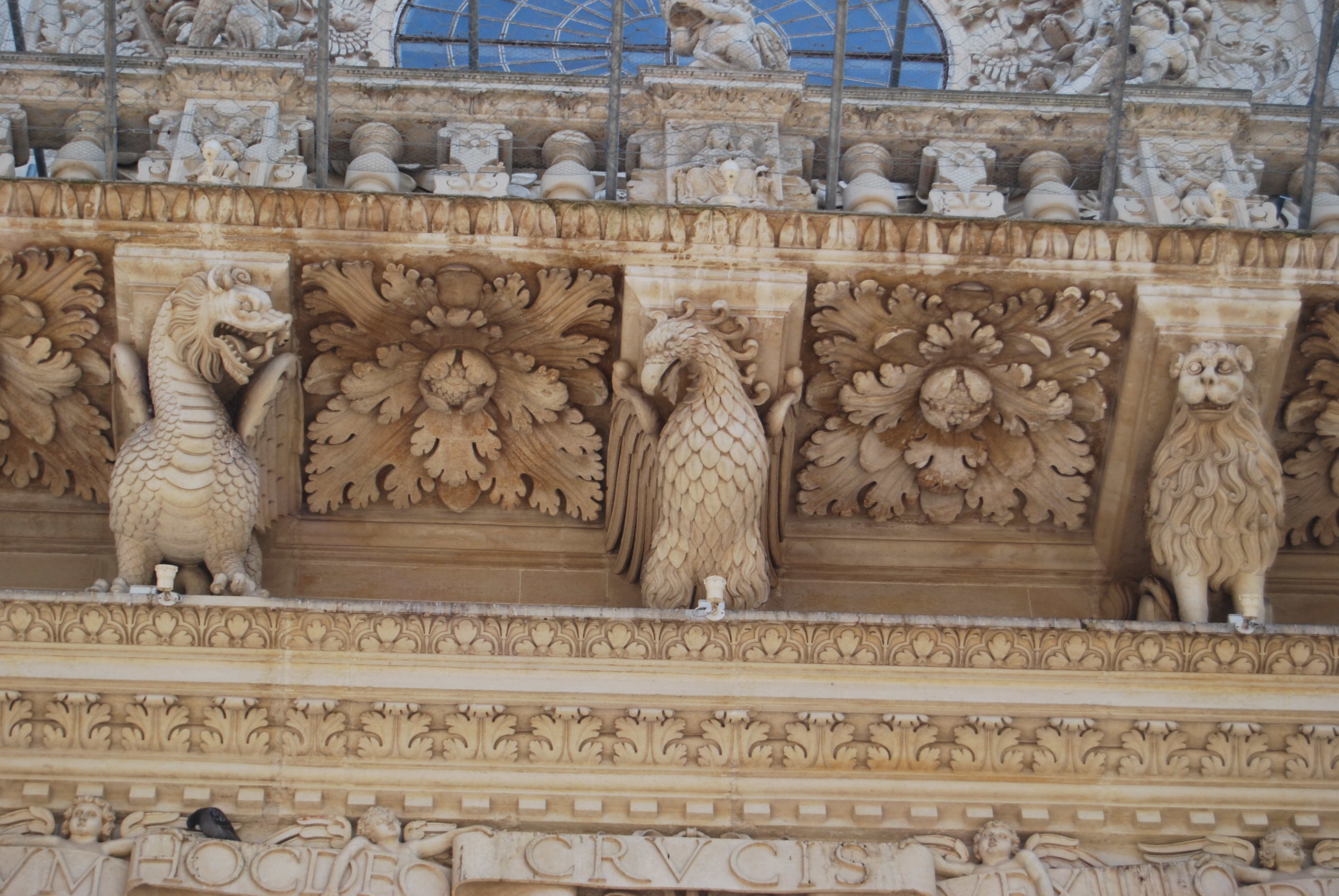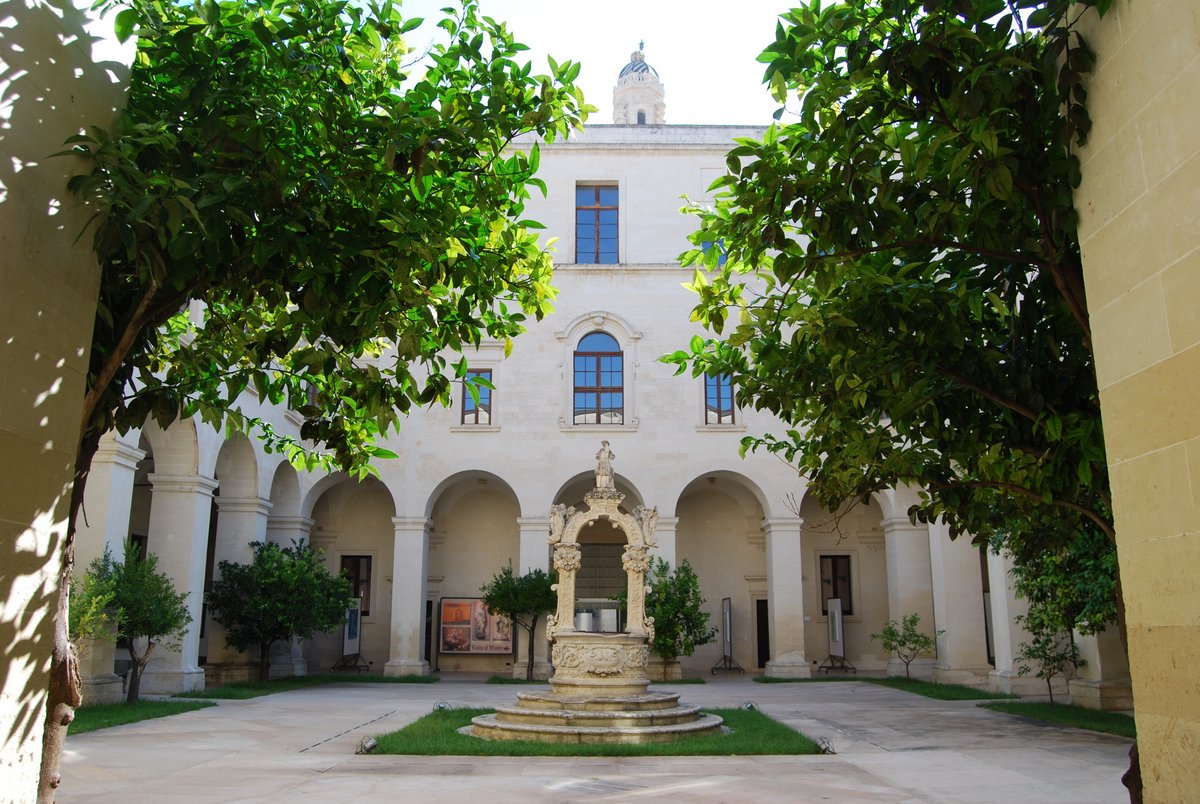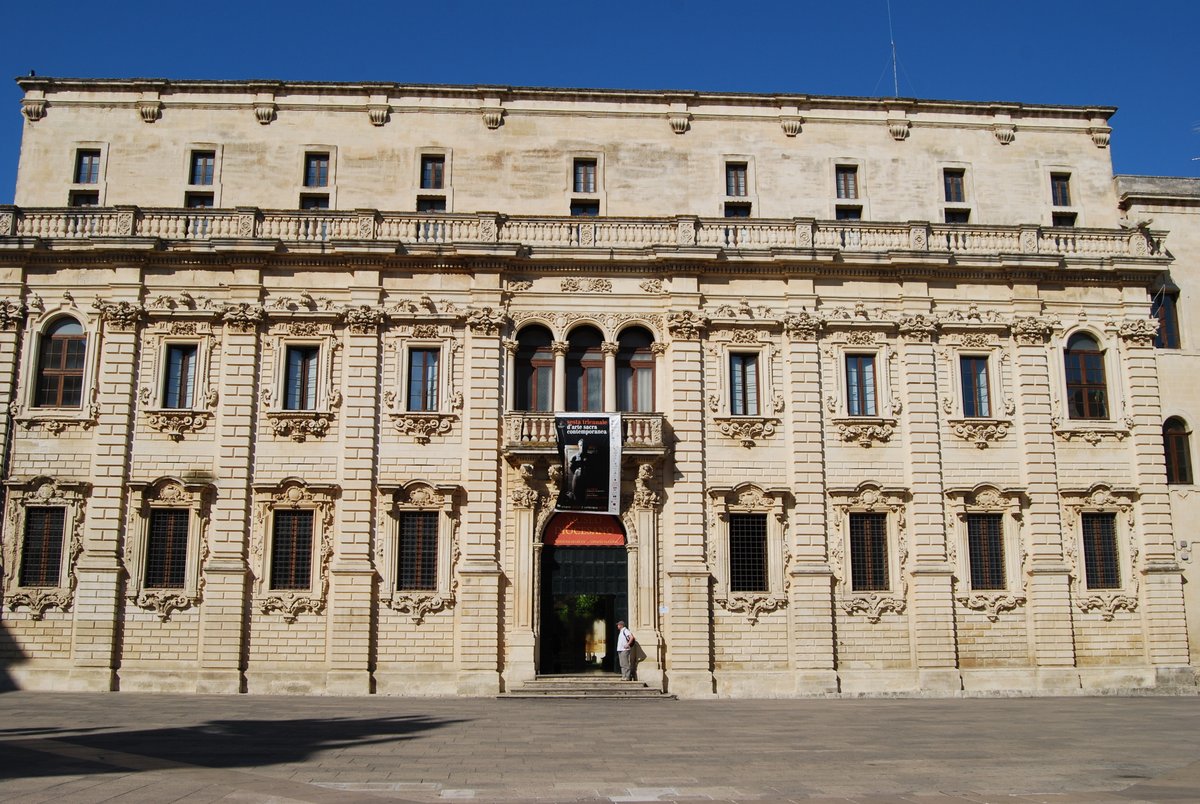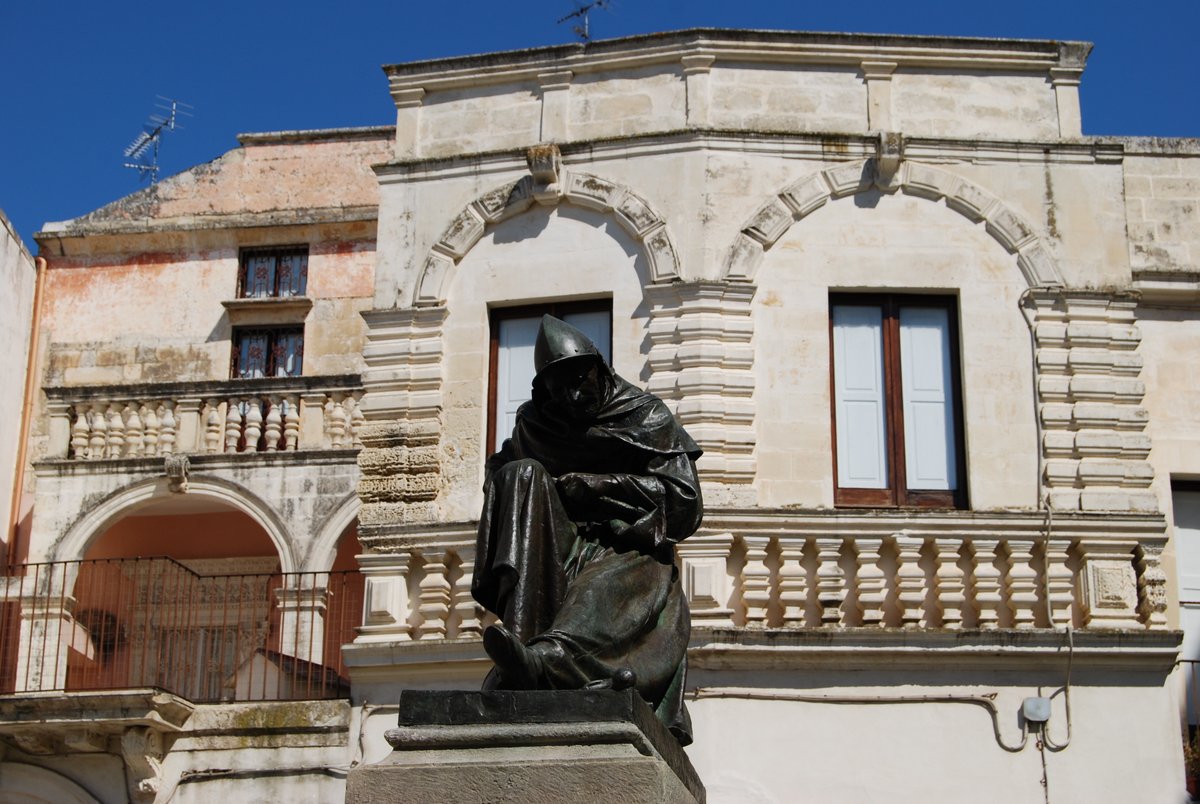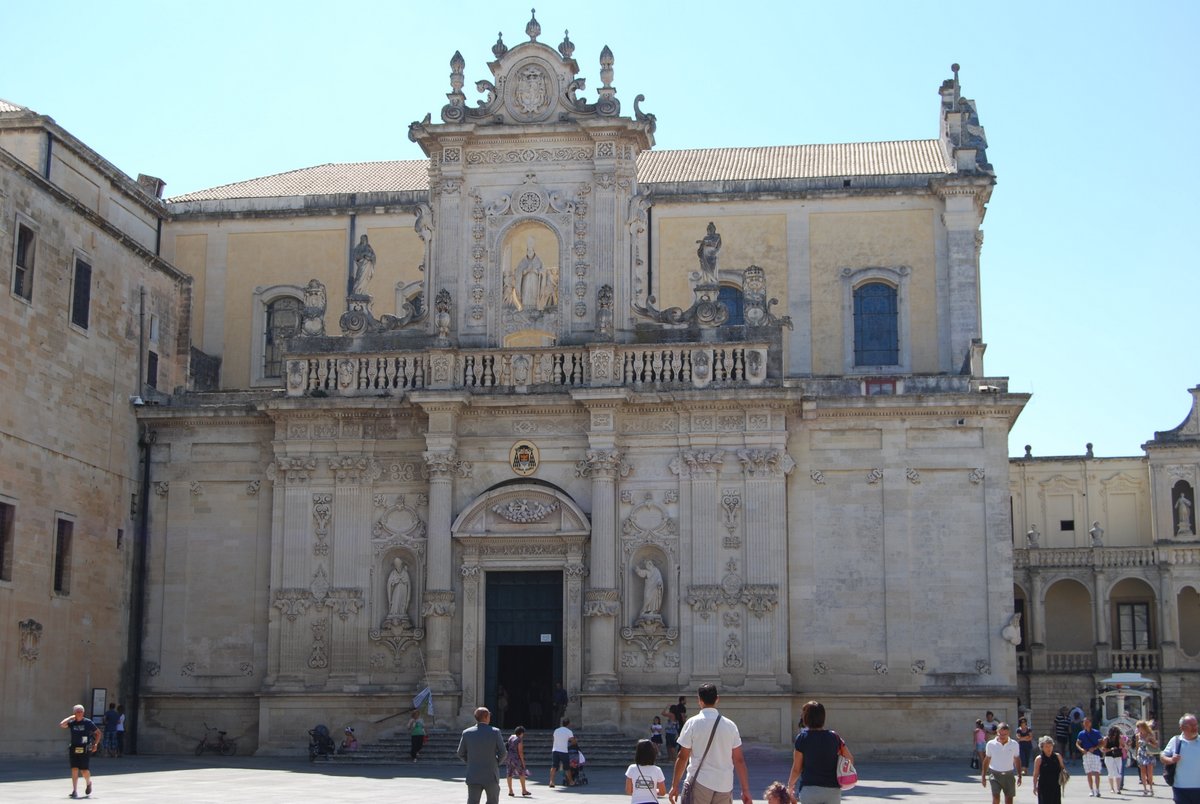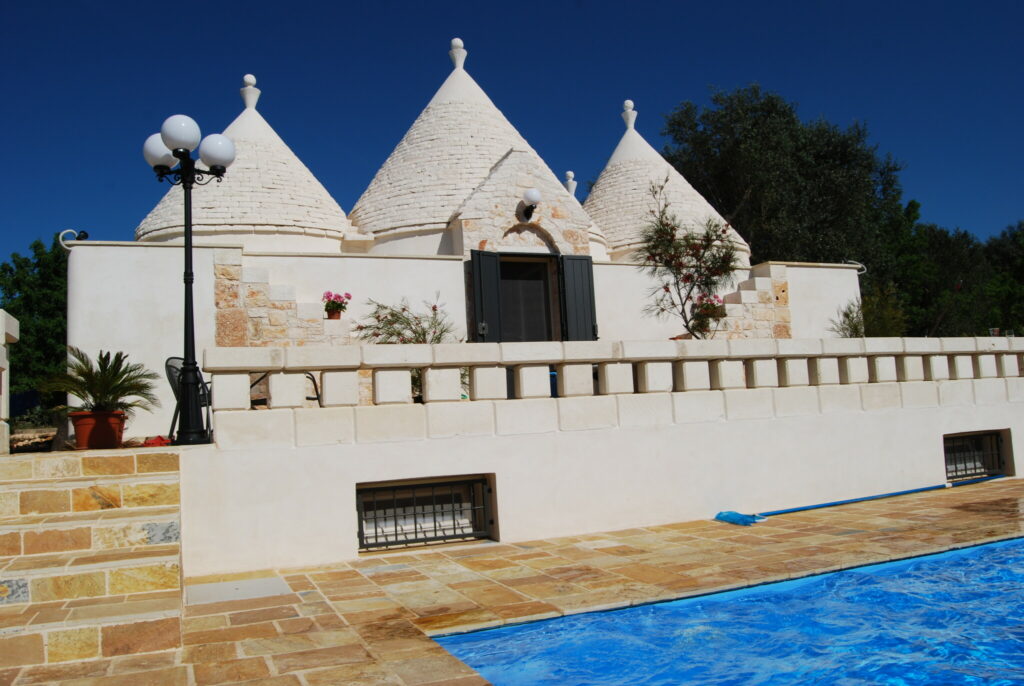Lecce, with a population of 95,000, is the largest city in the south of Puglia. It is probably the region's main tourist centre, and indeed in the south of mainland Italy generally. It is sometimes called "the Florence of the South", which is inaccurate and does not do justice to either place. The centre of Lecce is a concentration of baroque, predominantly religious, buildings, the result of an explosion of development in the 17th century when the city became especially prosperous.
The city was founded in pre-Roman years by the Messapii, and ever since there have always been strong cultural connections with Greece. Sacked by the Ostrogoths in the years following the collapse of the Roman Empire, the city was then ruled by Byzantines, and briefly by Saracens, Lombards, Hungarians and Slavs, before the Norman invasion in the 11th century; after which it became an important part of the Kingdom of Sicily.
The relatively sudden growth in the 17th century followed the success of the Holy League (an alliance of Catholic maritime states) in defeating the Ottoman forces at the significant naval Battle of Lepanto in 1571. This relieved the Salento of the constant threat of Turkish raids and invasion, allowing it and its main city Lecce to capitalise on the region's agricultural riches, resources and key trading location. Civic, commercial and especially church institutions competed to show off their wealth and power. The local limestone, an attractive light orange/yellow in colour, is both weather resistant and easy to carve, So if elaborate decorated buildings appeal, Lecce is ideal - you will not come across a more densely packed display of saints, flowers, vases, animals, birds, fish, angels, little boys (putti), dragons, etc. anywhere else in the world. As you walk in Lecce centre, it is interesting to reflect that most of this was created round about the time of the English Civil War, Great Fire of London, Samuel Pepys etc.
The heart of historic Lecce is around the Duomo and Piazza Sant'Oronzo, which are linked by Via Vittorio Emanuele. There are about 20 significant baroque churches within a few minutes' walk of Piazza Sant'Oronzo - we describe a few of these below, including especially Santa Croce, which is the pinnacle of baroque church architecture in Italy. The Castello and the important Roman sites are all in or close to Piazza Sant'Oronzo.
If you go to Lecce by car, you will need to park outside the central area; there are plenty of options. Lecce is easily reached by train from all over Puglia, with direct trains from Foggia, Bari, Ostuni and Brindisi. It is the "end of the line" for the long distance trains from Rome, Turin, Venice, Milan and Bologna. If you arrive by train, just head straight ahead from the station along the tree lined Viale Oronzo Quarta, keep straight on (crossing a main road) as streets get narrower, and after a few minutes you reach the Duomo and Via Vittorio Emanuele.
Piazza Duomo
Thi is a large open space almost totally enclosed by the Duomo itself and related religious buildings. The main entrance to the Piazza is from Via Vittorio Emanuele, but this is surprisingly narrow, hiding this important public space from the nearby commercial life. The Piazza is overlooked by a 54 metre high Campanile.
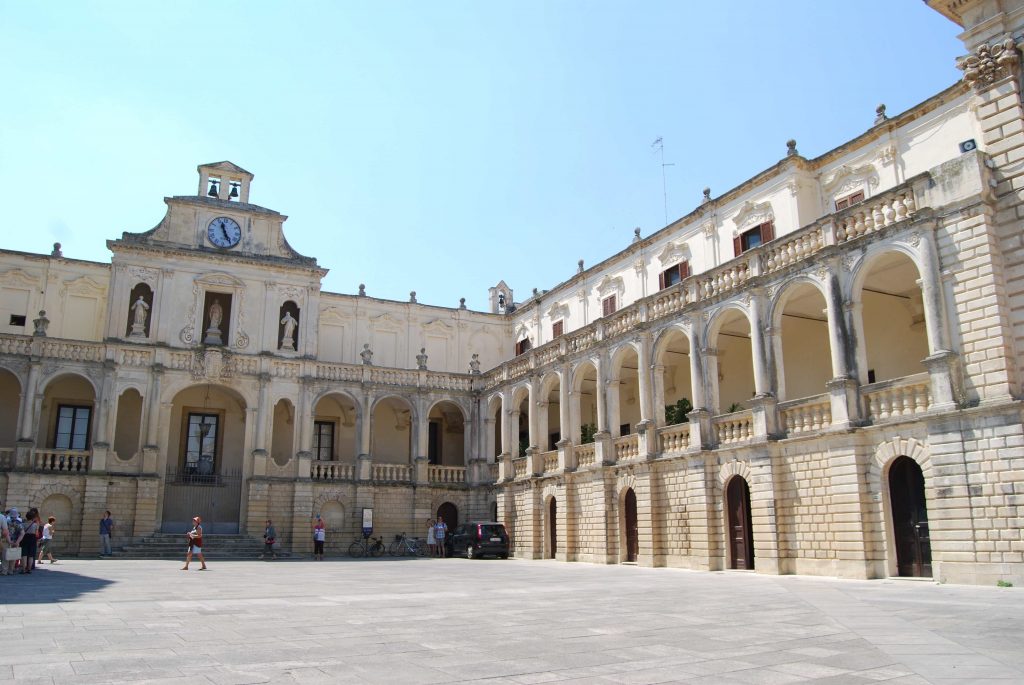
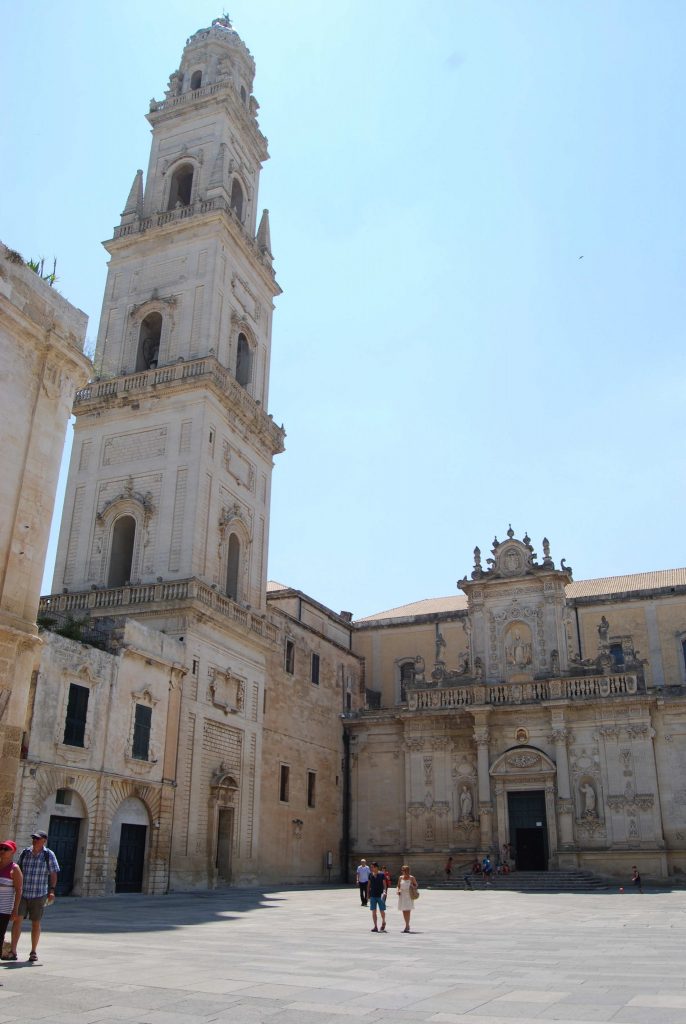
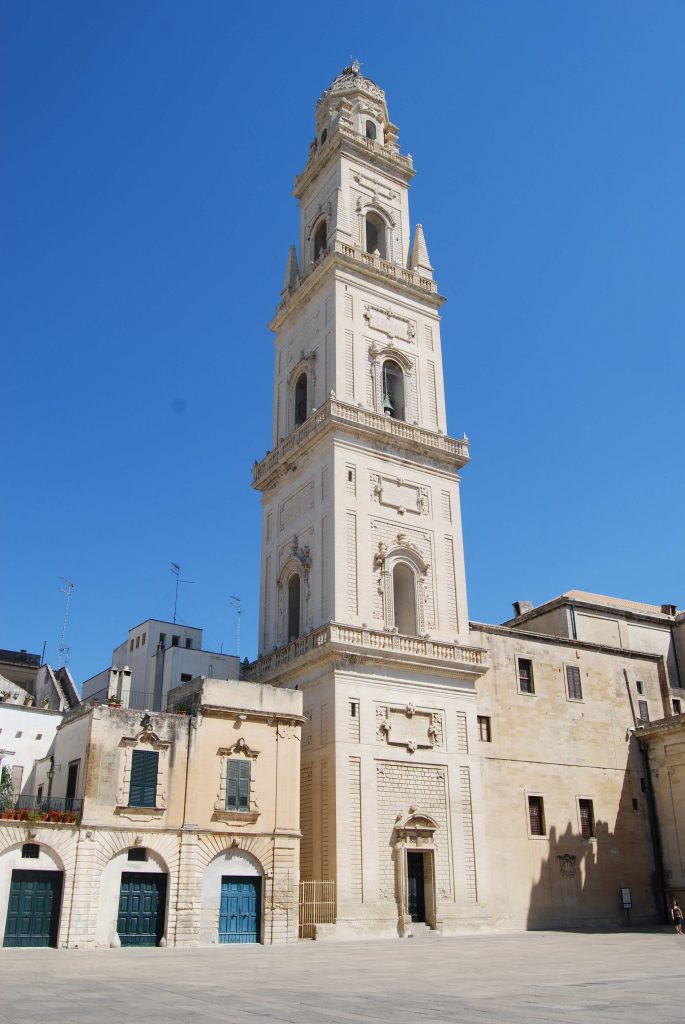
The Cattedrale di Lecce (Duomo) is dedicated to Maria Santissima Assunta, and was first constructed in 1144, before being re-built in 1230, perhaps due to problems with the foundations. In the late 16th Century the cathedral was again suffering structural problems and the look of the building now, ornate inside and out, was largely determined over the following 100 years.
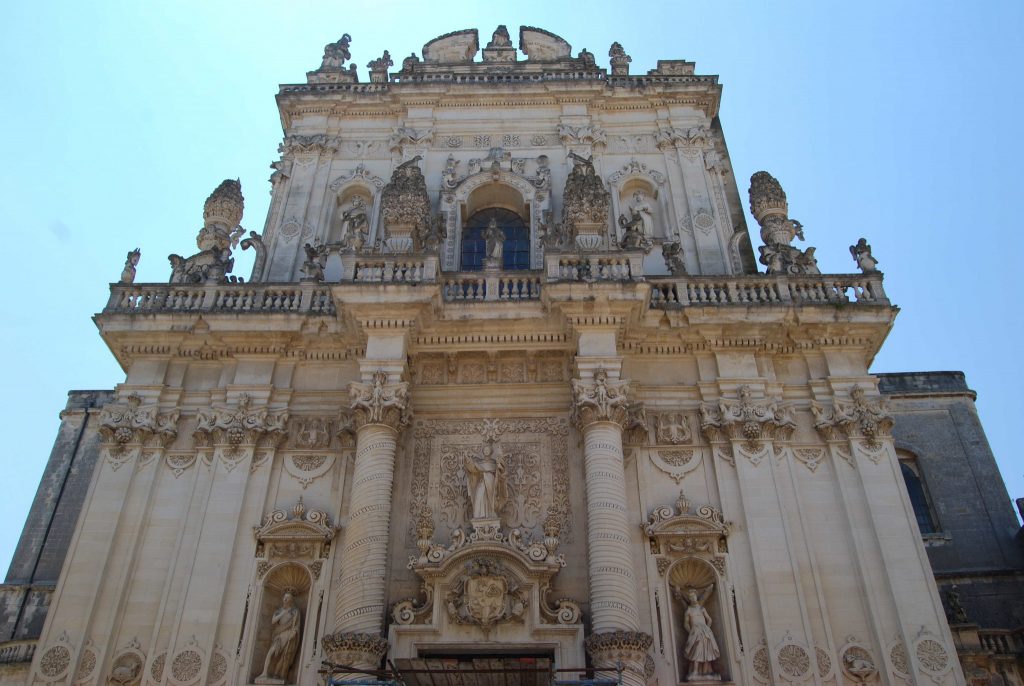
All the buildings in the Piazza Duomo are designed to impress and are decorated in great detail. The most impressive is the solid and imposing Palazzo del Seminario. This was built 1694-1709 and an extra attic floor added in 1629.
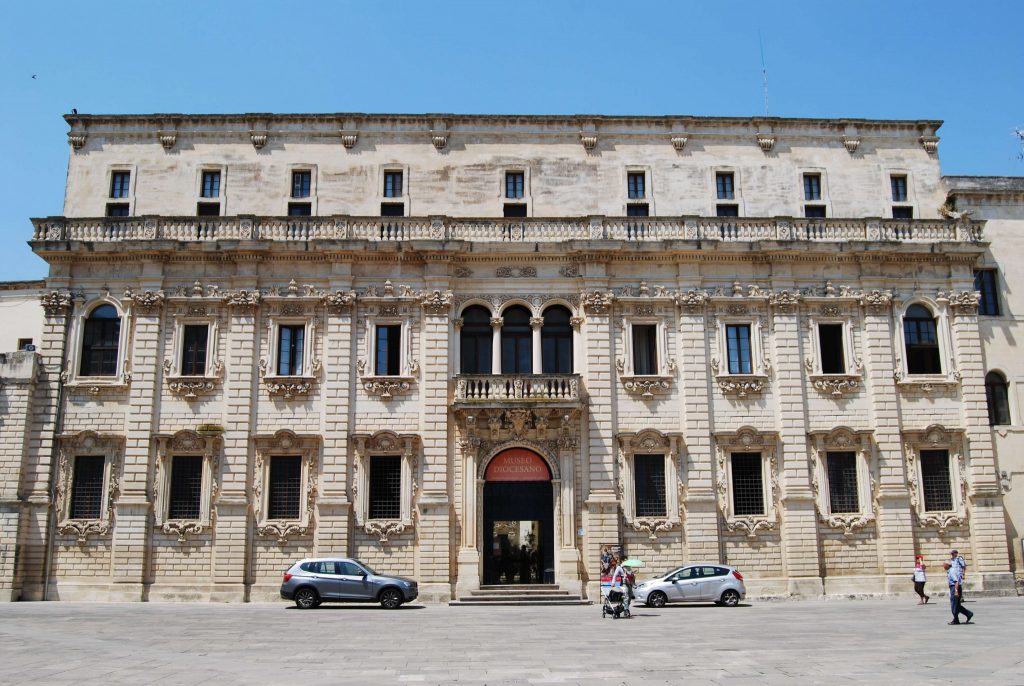
Today this building houses various offices, archives and an important library connected to the Diocese of Lecce. It also houses the Diocesan Museum. This includes paintings, sculptures, silverware and liturgical vestments describing the religious life and history of Lecce. The museum is open 9.30-12,30, Monday to Saturday, cost 4 euros. If you don't want to visit the museum itself, pay a euro to go inside the cloisters; this is well worth seeing.
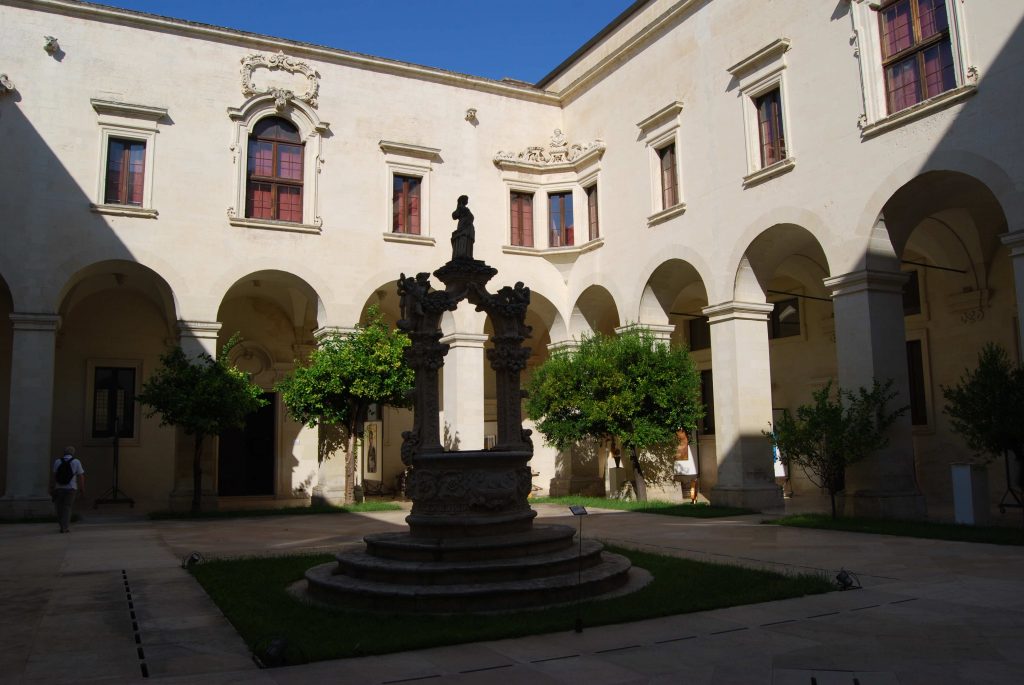
Via Vittorio Emanuele
This is a pedestrianised street with good shopping options and lots of bars, pastry/cake shops and restaurants. Several shops specialise in papier-mache figures, a traditional artistic feature of Lecce. Via Vittorio Emanuele connects the Piazza Duomo with the Piazza Sant'Oronzo, the civic/commercial centre of Lecce. It is a lively street, especially in the evenings. You will be approached by people inviting you to sample cakes and pastries, for which Lecce is justifiably famous.
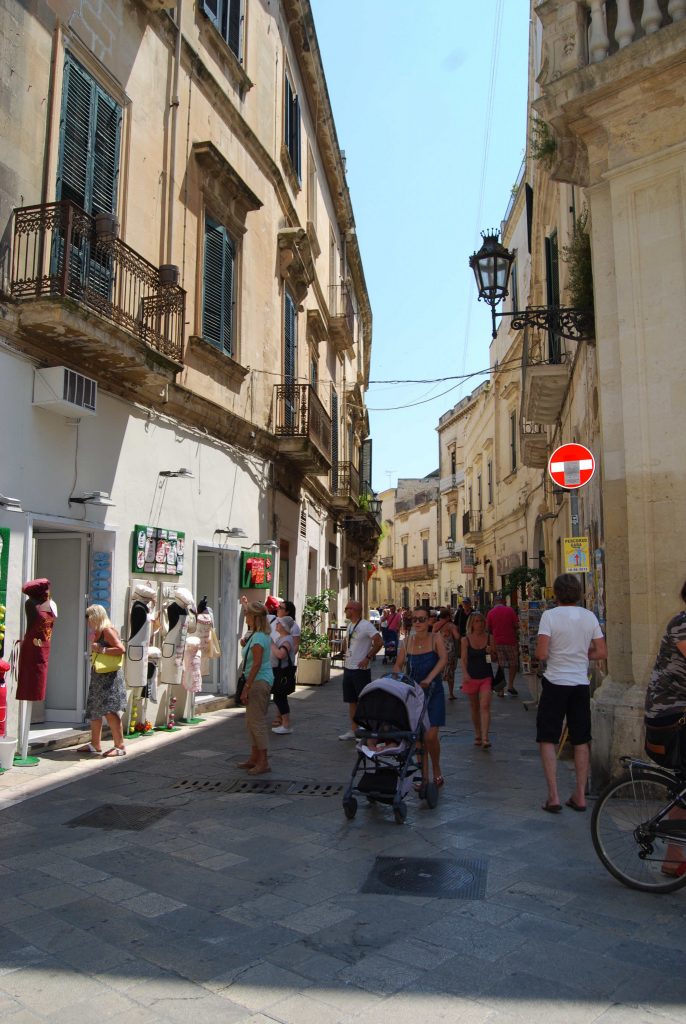
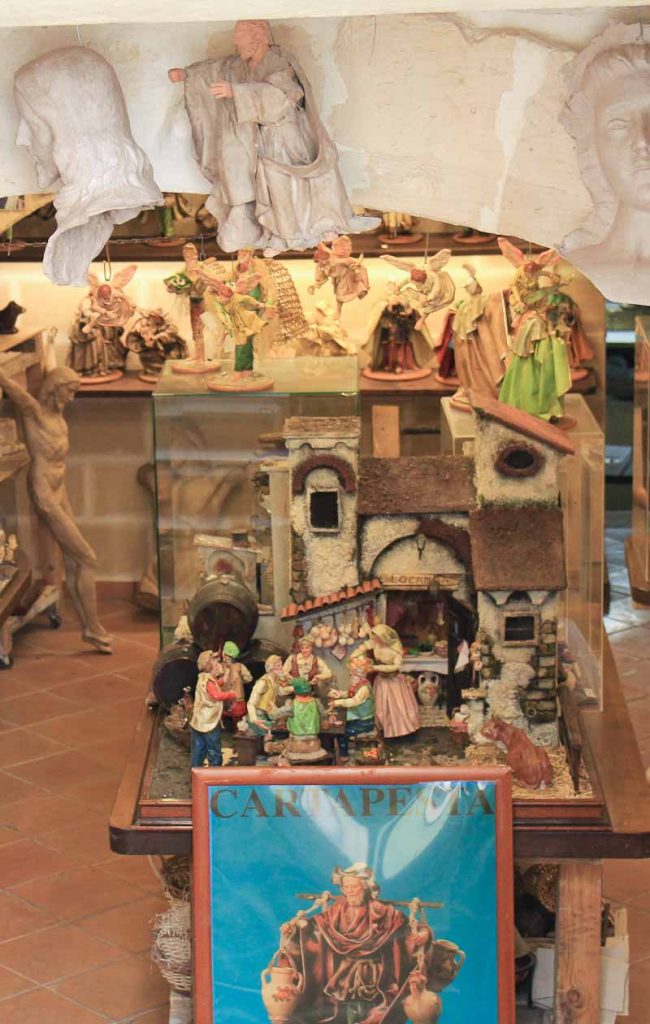
Piazza Sant'Oronzo
This piazza is the "heart" of Lecce, but is rather unattractive, dominated by large 20th century buildings and still over populated by cars, either moving or parked. There is a new information centre where you can pick up leaflets etc (this is the best of several information points in Lecce, most of which are little more than private travel agencies).
In the middle of the Piazza is the 29 metre high Colonna (Column) surmounted by a 5 metre Statue of Sant'Oronzo, who was the first Bishop of Lecce in the 4th century. The column itself is of Roman origin, the twin of one in Brindisi which marks the end of the Appian way, a present to Lecce from the City of Brindisi in 1681. This was when Sant'Oronzo became patron saint of Lecce as well as Ostuni; he is credited with saving both towns from the plague. The marble column then was in ruins on the ground in "drums" in Brindisi - the present to Lecce was the inspiration of the then mayor of Brindisi, but was heavily resisted by the citizens of that city, and there have been several moves since, even to this day, to have it returned and erected in its original position. The statue was fashioned in Venice in 1793 to replace a previous one damaged by fire - it is a hollow wooden structure covered in bronze, and was just popped on top of the column in 1881. (NB March 2019 - The column and statue are being restored. The obelisk is covered with scaffolding and sheets. The statue was removed by a tall crane ion 30 January 2019 - restoration of its wooden framework underneath the bronze is a tricky operation and could not be done while it remained aloft. While the restoration is under way the statue is housed in the entrance hall of nearby Palazzo Carafa, headquarters the Municipality of Lecce, where it can be seen by the public. It is thought the restoration work will last another year but no promises. NB August 2022 - restoration work still under way).
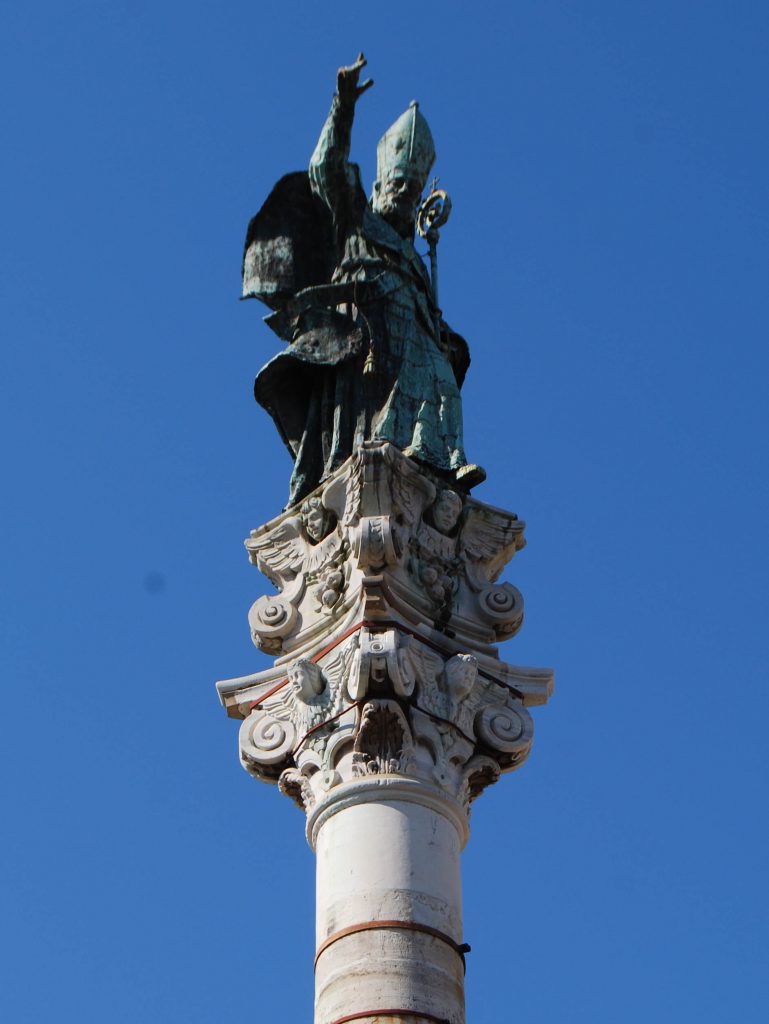
Roman Amphitheatre
The unique feature of the Piazza Sant'Oronzoi is the Roman Amphitheatre. The remains of this huge structure were uncovered only about 100 years ago, when the new Banca d'Italia building's foundations were being dug; and the site was only properly excavated after 1945, with about half of it now exposed to view, the rest buried under surrounding buildings. It can all be seen freely from the Piazza; as well as the tiered seating the remains of animal pens etc can also be seen. In its heyday (1st and 2nd centuries AD) the amphitheatre could accommodate 25,000 spectators, relatively small by standards of the time. It hosted gladiator contests, wild animal fights, public executions etc. Nowadays it is the base for open air concerts in summer and nativity scenes at Christmas.
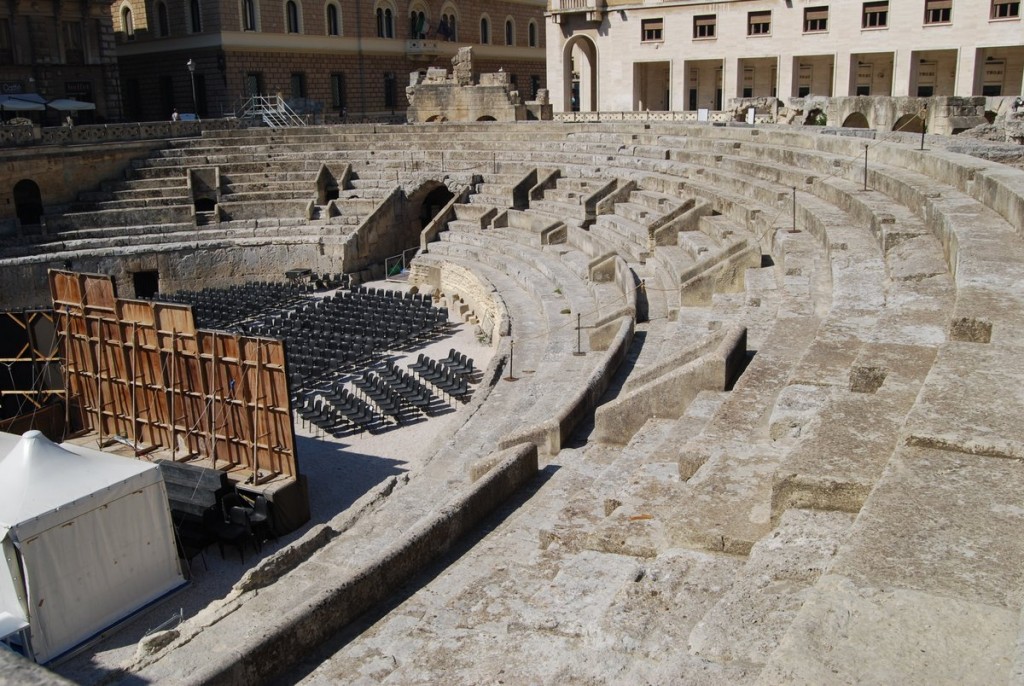
Teatro Romano
Near the Piazza Sant'Oronzo and the Piazza Duomo, but tucked away in side streets, is another major Roman building, the Roman Theatre (Teatro Romano), not to be confused with the Amphitheatre. This was discovered by accident in 1929, during some works carried out in the gardens of nearby historical palazzi. It has subsequently been excavated, and in 1990 a small museum was attached to it.The museum and theatre are open to the public 9.30am-1.00pm, Monday - Saturday, charge 3 euros.
The theatre was built in the first and second centuries, and was an important feature of Roman Lecce, hosting all kinds of plays and other performances; it could accommodate about 5000 spectators. It is cut into a rocky depression. There is a semicircular "orchestra" with original stone slabs where important people were seaed. On the large stage can be seen a channel for curtains plus recesses for scenery. The cavea (auditorium) could seat about 5000 people. It is made of limestone blocks divided into six segments by flights of steps.
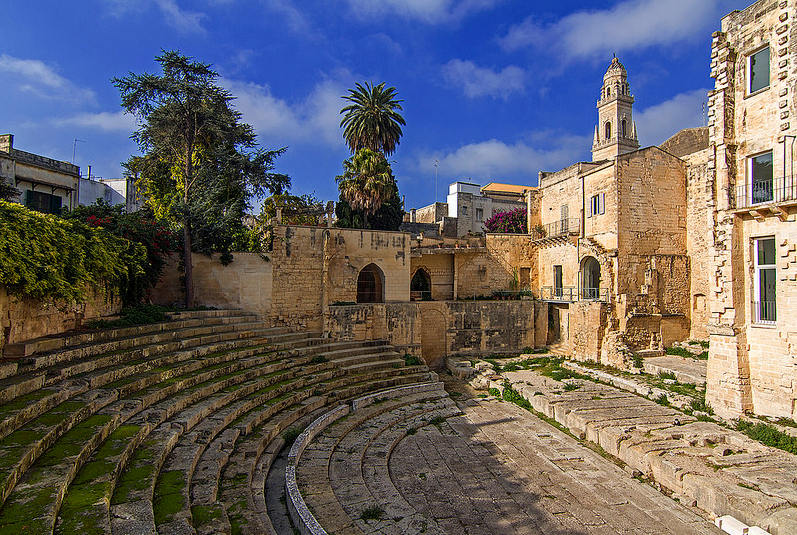
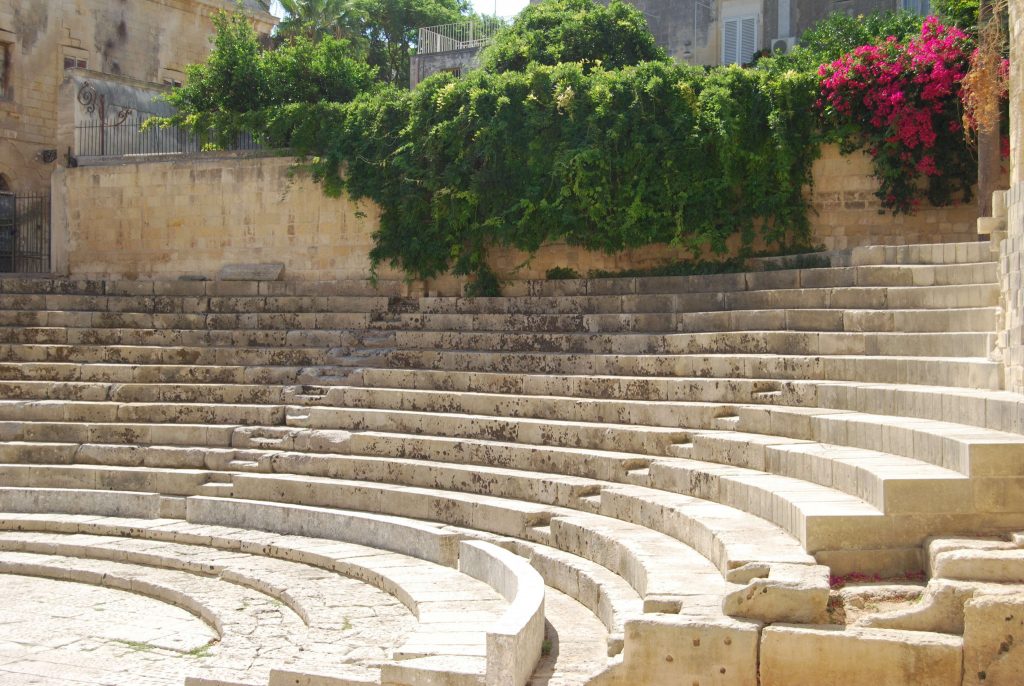
The small museum contains a few displays about Roman theatre in general, and artefacts such as masks and costumes. There is an interesting model of what the complete theatre would have looked like.
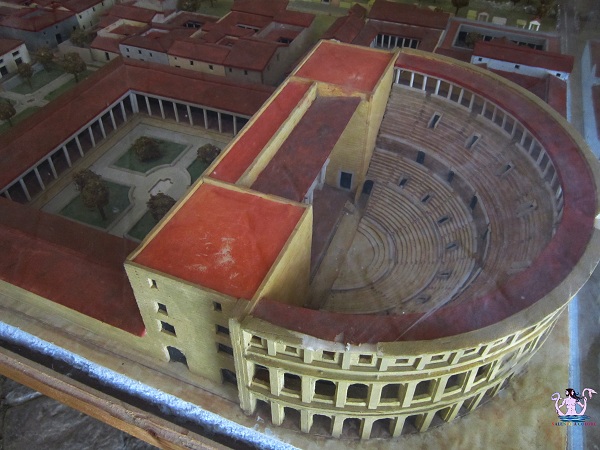
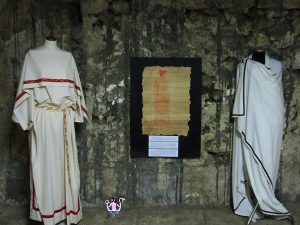
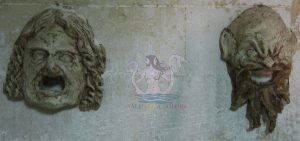
Castello di Lecce
Close to the Piazza Sant'Oronzo is the Castello di Lecce. This was built in the 1550's, part of the wave of castle building in Puglia instituted by the Emperor Charles V to defend the region against the Turks (others included Otranto and Copertino). It is a large and solid quadrilateral of bastions surrounding a courtyard; the original moat and bridges were eliminated n 1872. Never needed for defence, the castle served as a barracks, a residence and for a time as a theatre; in 1983 it was taken over by the local municipality and used as the headquarters of Lecce's cultural service. It now houses exhibitions, events and a museum of papier-mache figures, for which Lecce is famous.
The castle has an imposing front gateway. It is possible to walk through the castle from front to rear, going through the main central courtyad which has been excavated. You can also walk round the perimeter to appreciate its size and character. To go inside costs 5 euros, but this is mainly to see the papier-mache museum and any other exhibits.
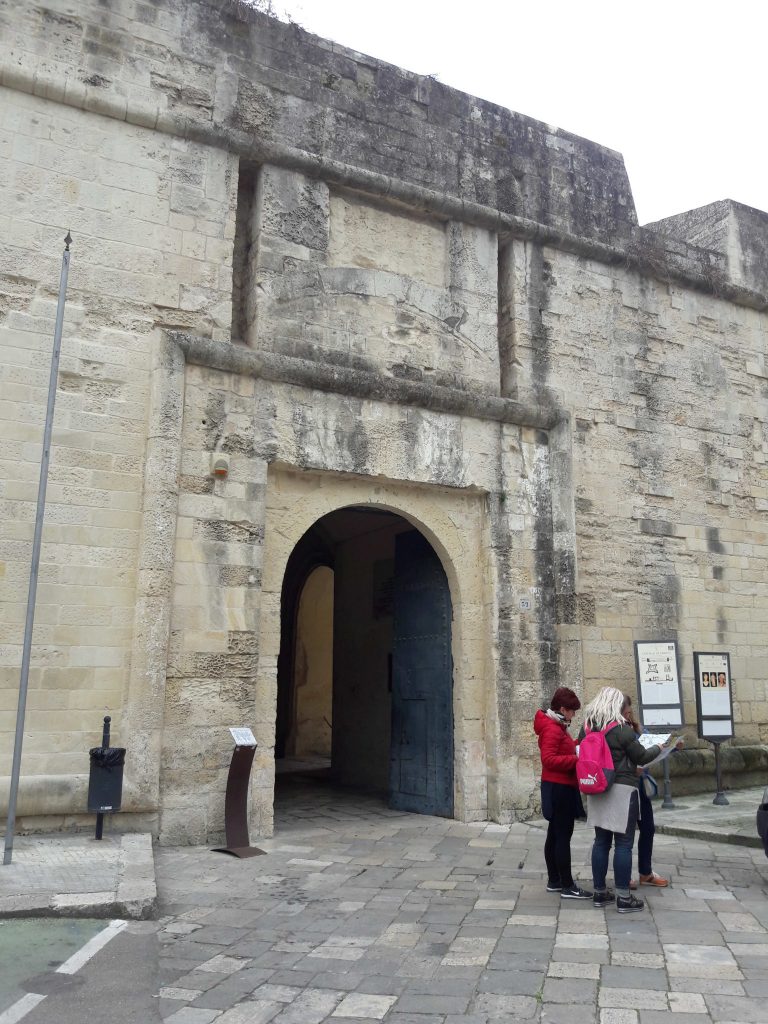
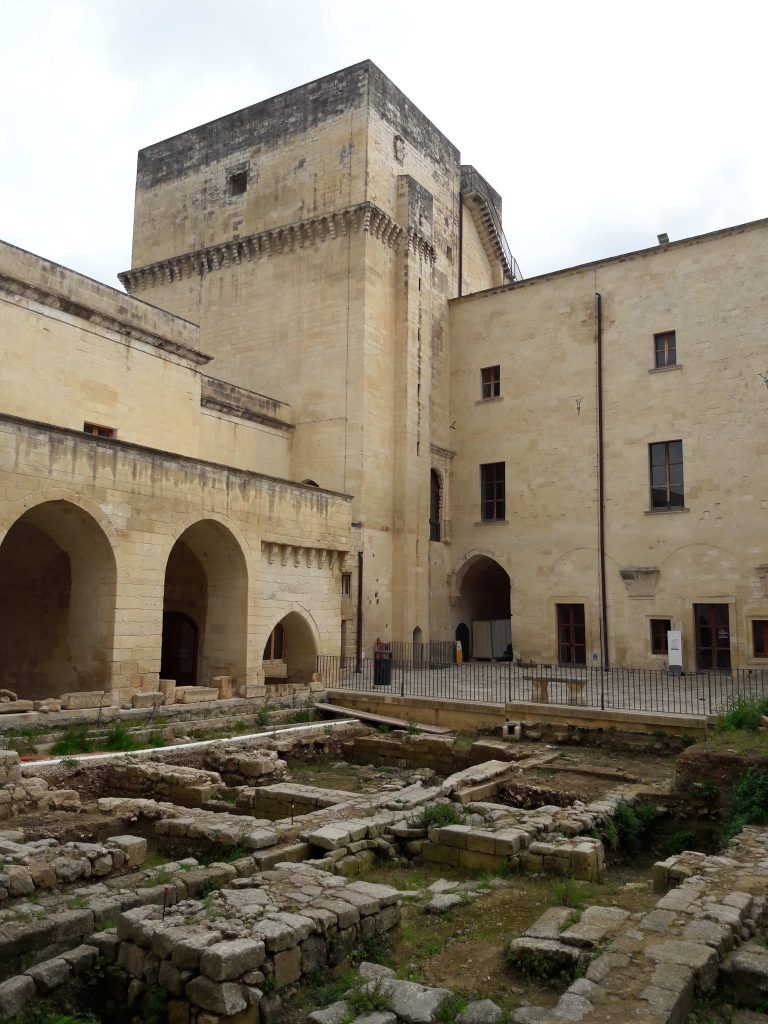
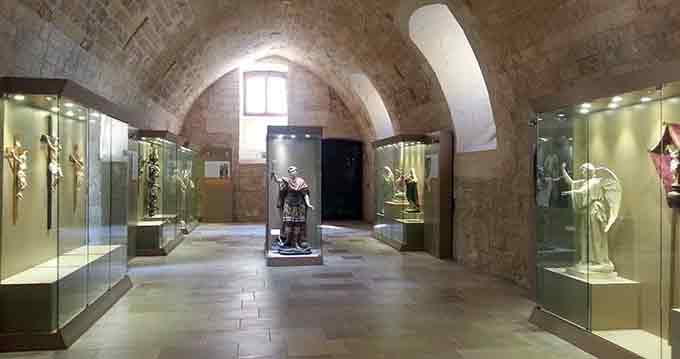
Three Baroque churches
Chiesa di Sant'Irena
This church overlooks a small piazza on Via Vittorio Emanuele, between Piazza Duomo and Piazza Sant'Oronzo, so it may well be the first major baroque church a visitor encounters. It was built in the period 1591-1639 by Francesco Grimaldi of Turin, dedicated to sant'Irene of Lecce, who was the patron saint of the city until being displaced as such by Sant'Oronzo in 1656. This was the church of a male monsatic order known as the Theatines, which was suppressed in 1866, but with the church left as a place of worship.
The façade is in two sections. In the lower section, columns are separated by empty niches and sculpted scrolls; also the main door, above which is a statue of Saint Irene designed in 1717 by one of Lecce's leading baroque architects, Mauro Manieri. Above the linear cornice which divides the two sections is the civic emblem of the city of Lecce. The upper section of the facade is similar in pattern to the lower, with a large central window, capped by a triangular topmost unit ("tympanum") which has the symbols of the Theatine order and a Latin inscription referring to "Saint Irene - virgin and martyr".
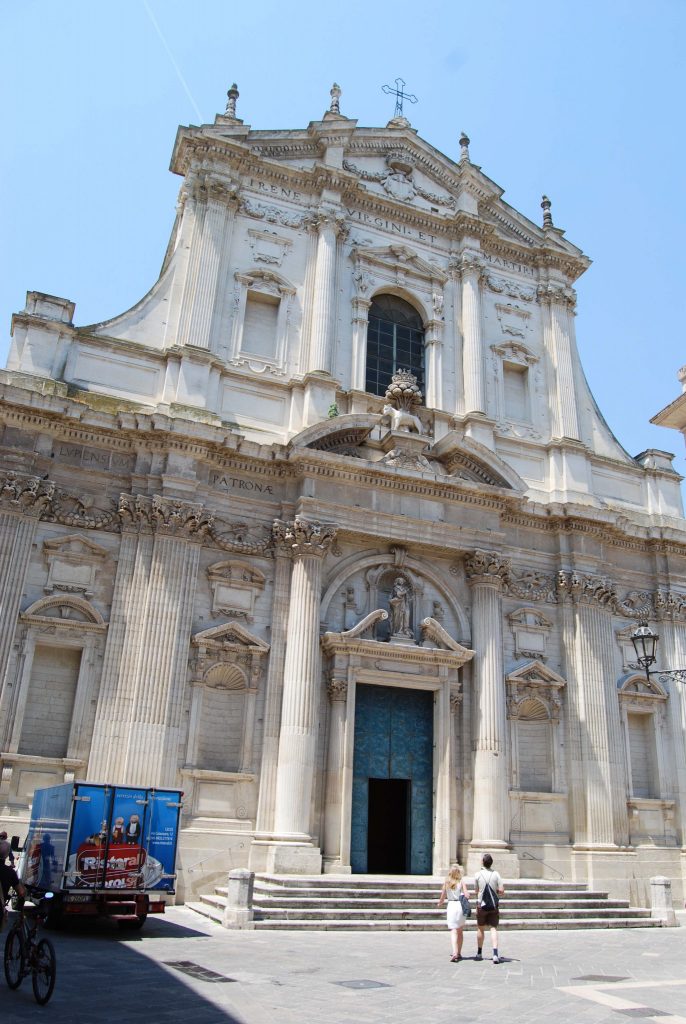
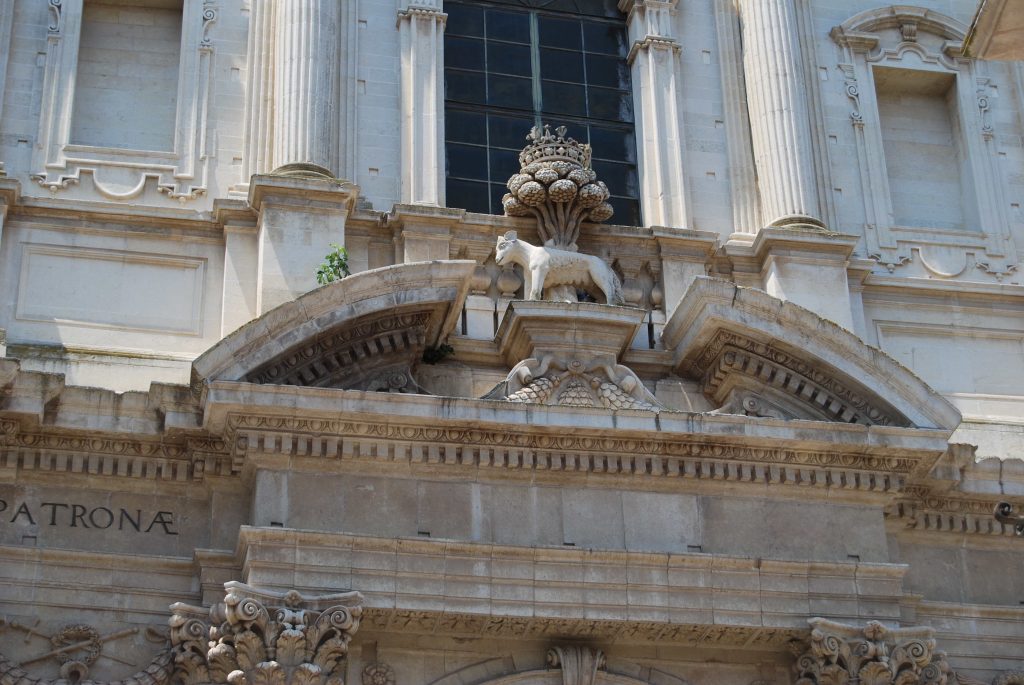
Inside the church is cross-shaped, with a single nave and transept, with about a dozen chapels and altars. The whole is lavishly decorated with paintings, sculptures etc.
Chiesa di Santa Chiara
This church is situated close to the Roman Theatre. Although construction commenced in 1429, it was finished and totally restored in pretty much its present form in the period 1687-1691. The facade looks somewhat truncated because it lacks the usual triangular top section. It is ornately decorated with depictions of plants, angels and religious symbols. The doorway is flanked by fluted columns and surmounted by the coat of arms of the order of Santa Chiara. There is a pattern of empty niches in both lower and upper sections.
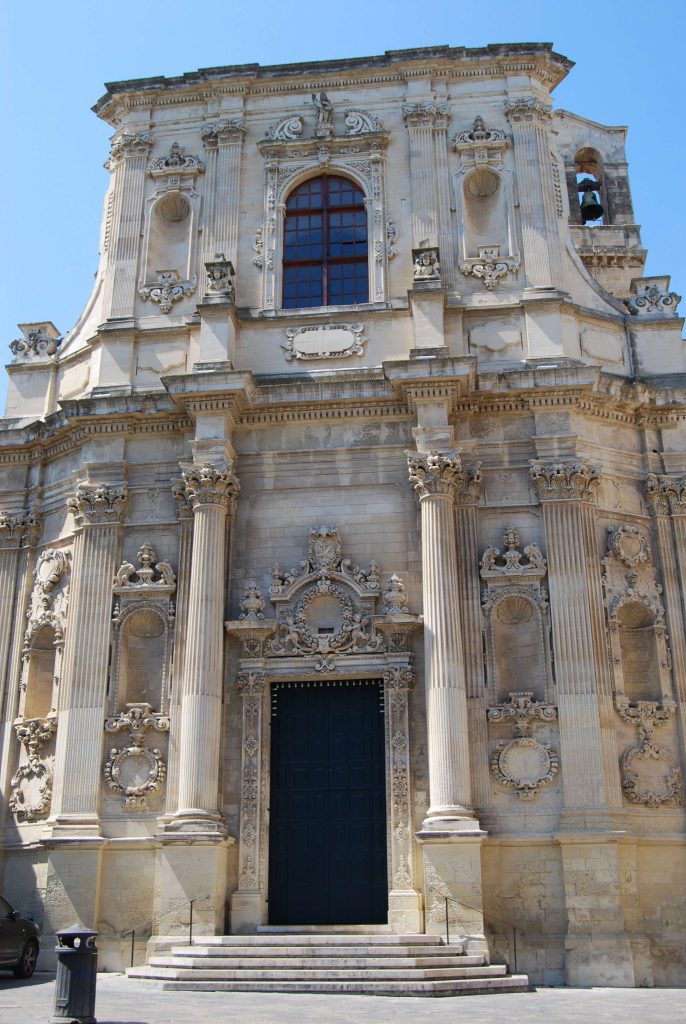
Inside the church is very light due to seven large windows. The whole is a mass of sculptures, carved images, wooden statues of saints and altars with paintings. The imposing high altar includes a statue of Santa Chiara di Assisi.
Chiesa del Gesu
In 1575, a very old Greek Orthodox church on this site was demolished to be replaced by this church to be the base of the Jesuits in Lecce. Construction took place over the next 50 years or so.

The facade is comparatively restrained in design compared with other churches nearby built a little later. The lower section is a simple pattern of pillars and empty niches. The doorway is surmounted by the Jesuit emblem flanked by sculpted angels. The upper section is has more decorative features and three windows, with a small statue of the Child Jesus over the middle one. The roof pediment is decorated with religious imagery, and capped by a statue of a Pelican, a widely used symbol of a mother feeding its children.
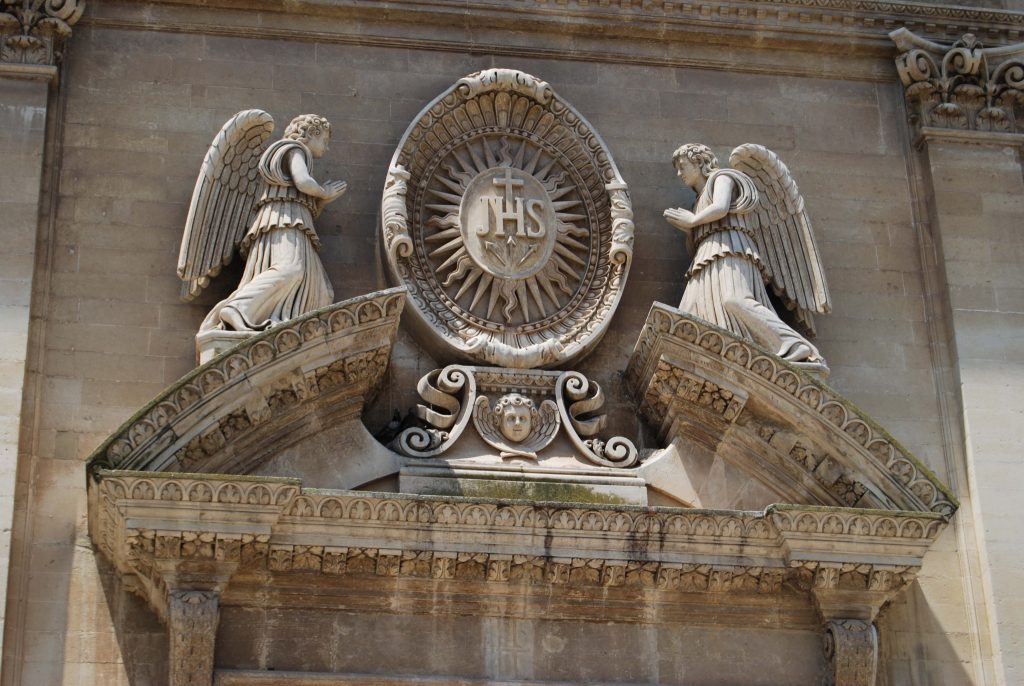
Inside there is a large nave flanked by various altars and chapels. These are all intricately designed and sculpted, and feature significant artworks. An important chapel is that dedicated to the Madonna del Buon Consiglo (the church is sometimes referred to by this name).
The main altar dominates however. This was created by in the mid 17th century by Guiseppe Cino (the leading Lecce architect of that time, responsible for many of the buildings created then). It is flanked by sculpted twisted columns, and contains a painting of the Circumcision by Jacopo Robusti. There are various sculpted figures, statues and paintings, all contributing to a magnificent overall impact. The wooden (walnut) stalls at the base were an 18th century addition and are attractively decorated with flowers and others symbols.
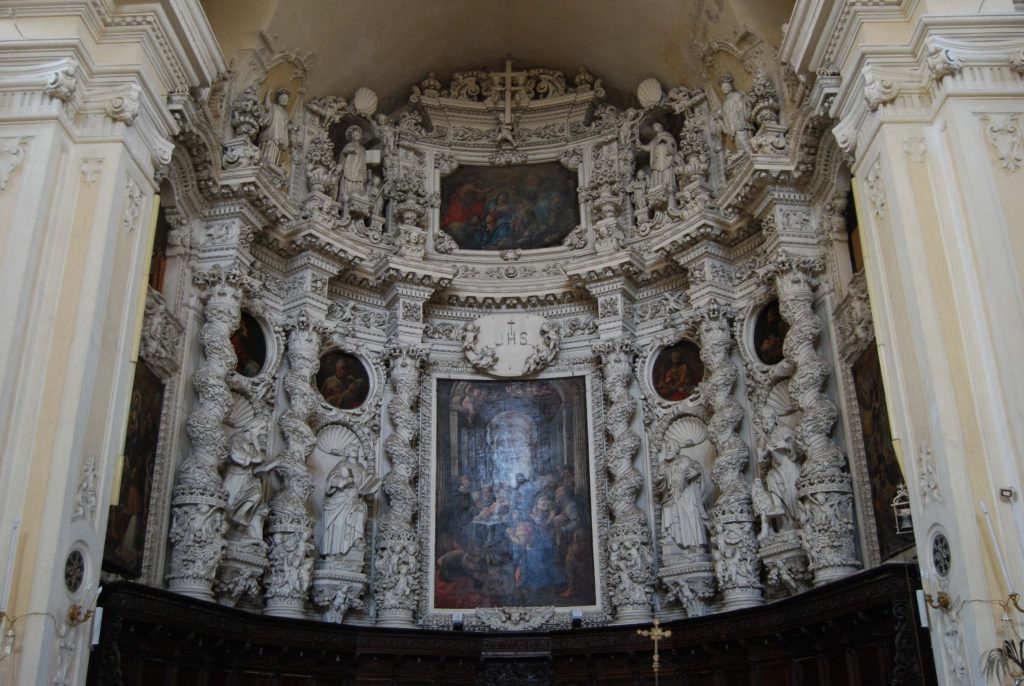
Basilica di Santa Croce
The Basilica di Santa Croce is the high point of baroque architecture in Puglia, and many would say it is the most important baroque building in Italy. Nobody visiting Lecce should miss this dramtic spectacle, especially its facade, which is intricately decorated and well worth studying closely.
The church is located on Via Umberto I, a narrow street just a short distance from Piazza Sant'Oronzo; there is no large open space in front of it, so it is something of a surprise when the street widens and the dramtic facade comes into view.
The whole building has been undergoing a lengthy period of restoration. On visits over five or more years before 2022, the facade was obscured by scaffolding and sheeting, and internal access was sometimes limited. However, work has now finished and the church, including the facade, can be viewed properly.
Although the church dates originally from 1353, the main construction took place over a long later period 1549-1646, supervised by a succession of leading local architects - Gabriele Riccardi, Giuseppe Zimbalo and Cesare Penna. It involved the most skilled masons, sculptors and artists available at the time. The site was created by demolishing buildings which had been the core of Lecce's Jewish quarter following expulsion of Jews from the city in 1510.
The famous facade is worth particular study. It is full of significant references and a good deal of history, so it is useful to know a little about it to help appreciation.
Overall the facade of Santa Croce symbolizes the triumph of Christianity over pagan myths - this was especially relevant at the time of construction, when the Turks had only very recently been dfeated and pushed back from threatening this part of Europe. The lower part represents the underworld where mythological figures such as sirens, harpies and dragons peek out from the capitals and pediment. This pagan world is overcome by the heavenly forces shown in the upper part of the facade, featuring flowers, plants, animals and angels.
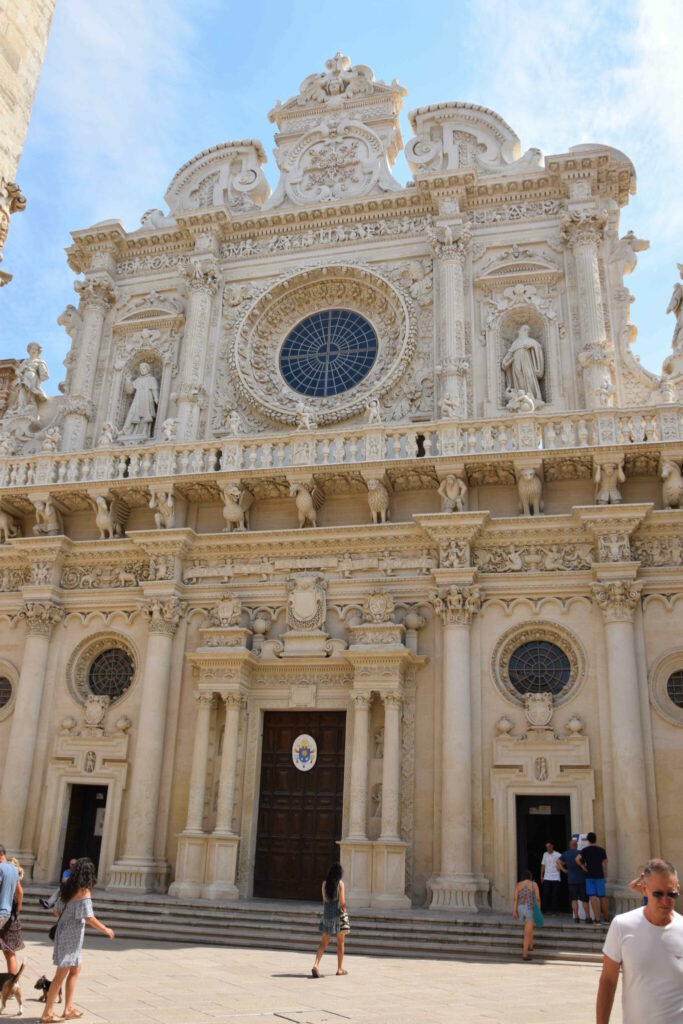
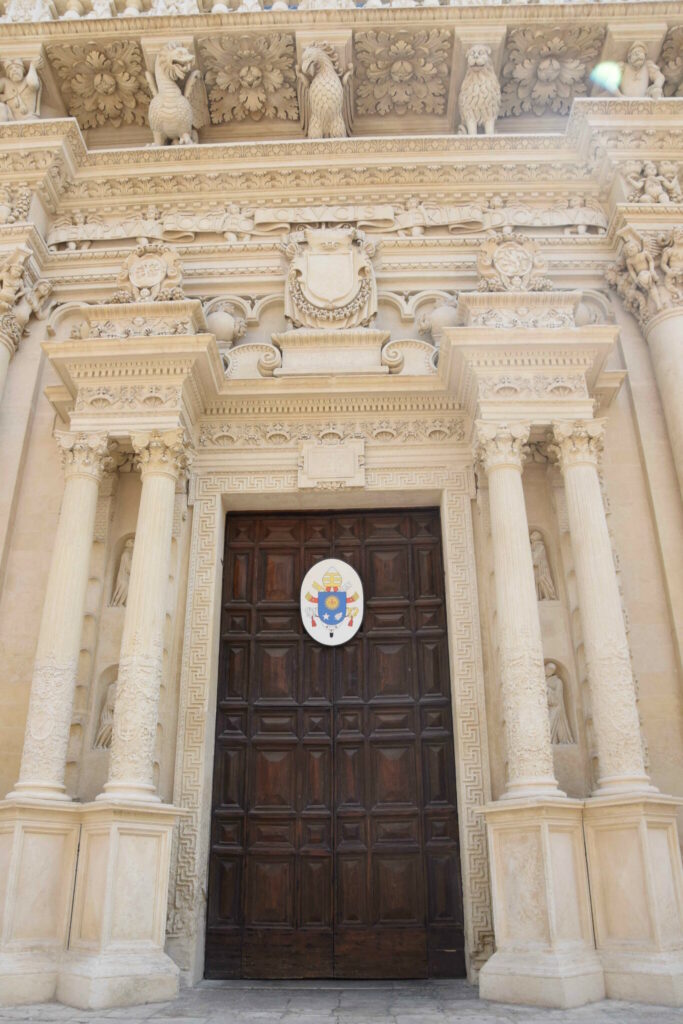
The upper part (which was designed by Cesaro Penna) is the most lavishly decorated, with a balcony held up by lions, griffins, dragons etc. In the middle is rose window encircled by bay leaves and berries. On either side of the rose window, there are two Corinthian columns which separate the central area from the sides where there are niches with statues of St. Benedict and Pope Celestine V. On either side of the front, however, stand two large statues of women, symbolizing Faith and Fortitude.
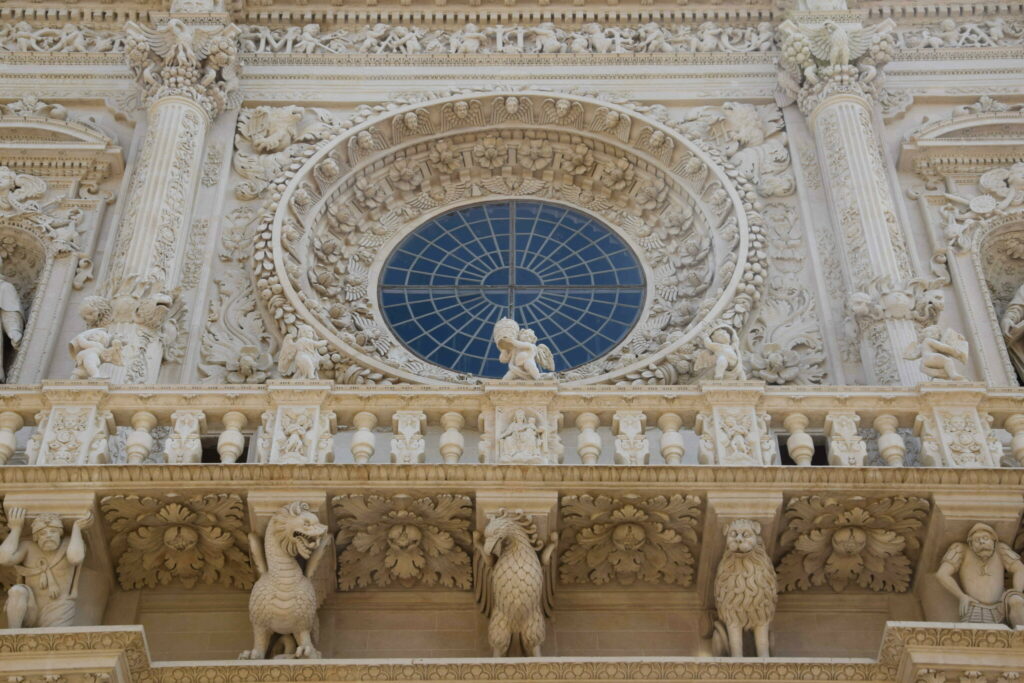
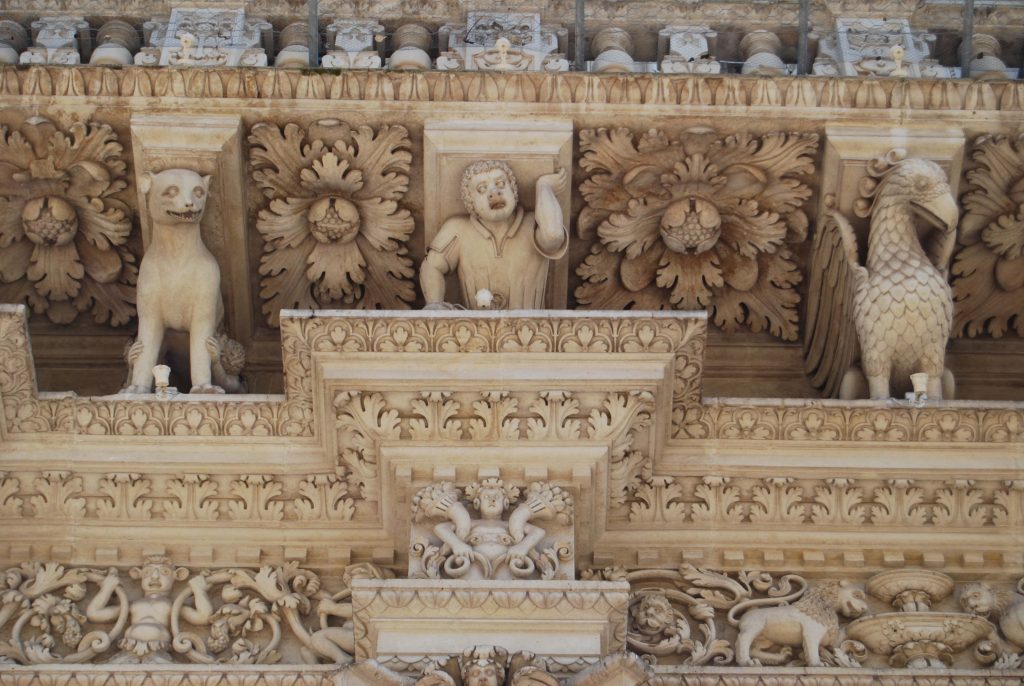
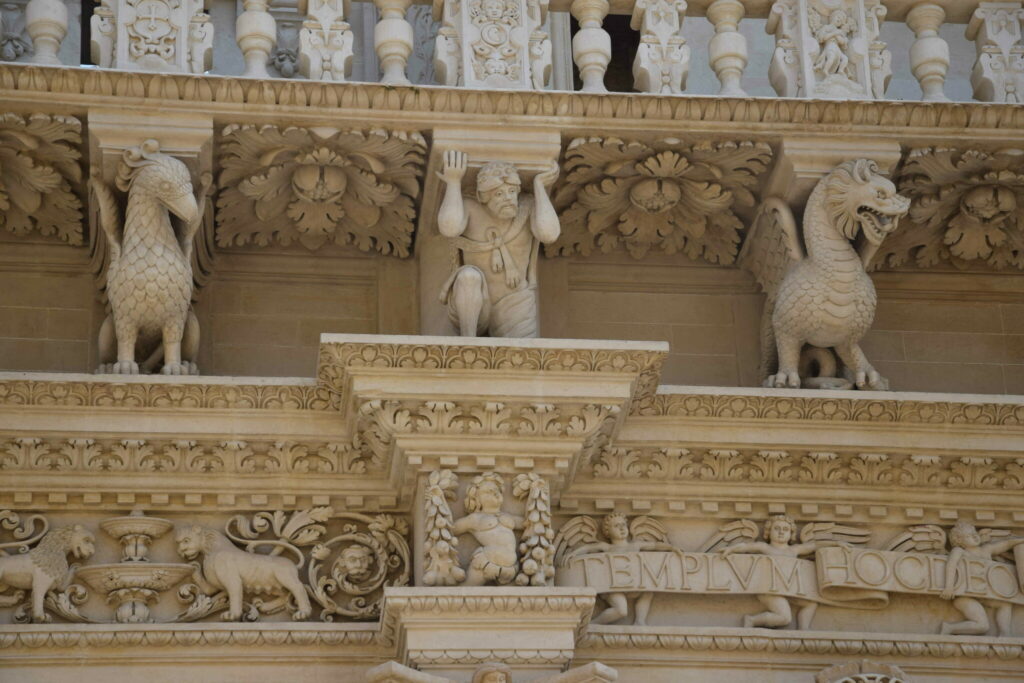
The facade is regarded by some experts as a specific celebration of the victory at the Battle of Lepanto in 1571. In this battle, the Western powers defeated the Ottoman Empire, which led to great economic and commercial benefits for all Salento, then known as Terra d’Otranto, which had previously been constantly under siege by the Saracens. The male faces (telamons) dressed as Turks are a reminder of the prisoners captured by the powerful Venetian fleet during the battle. The animals depicted in the balustrade are linked to the allied Christian powers: the dragon was the symbol of the Buoncompagni family of which Pope Gregory XIII was a member; the griffin symbolizes Genoa; the Hercules was associated with the Grand Duke of Tuscany.
The Basilica is freely open mornings and evenings. There is a high nave flanked by aisles containing chapels - 16 in all, every one regarded as a baroque art and sculpture masterpiece.
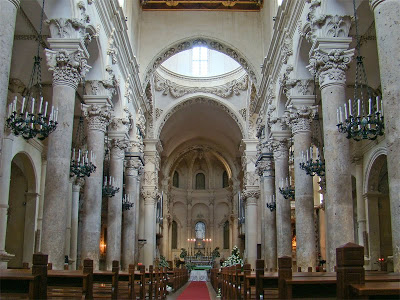
Artistically the most important chapel is that of of San Francesco di Paulo, on the left aisle. Designed in 1614/15 by Francesco Antonio Zimbalo, this has a central altar flanked by decorated columns. Between the columns are 12 sculpted panels describing the life of the saint, and the whole is surmounted by statues of angels and other symbols.
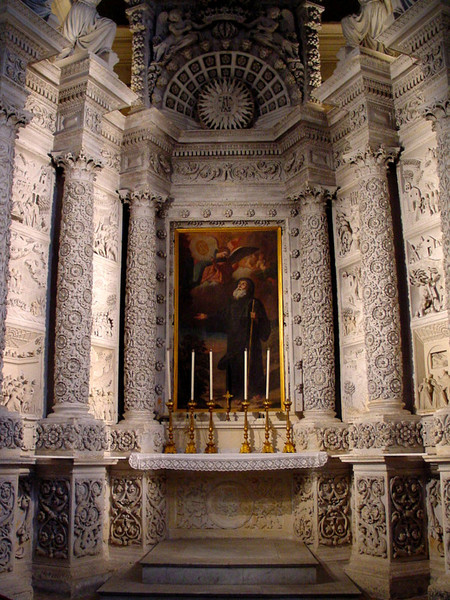
Next to the Basilica Santa Croce, and designed by Gabriele Riccardi as an integral part of the complex, is the Palazzo dei Celestini. This was developed for the Celestine monastic order.Construction started in 1549, but like the Basilica stretched on for over a century - the long section on Via Umberto I was built in 1659-1695 to designs by Giuiseppe Zimbalo and another leading Lecce architect, Guiseppe Cino.
After the monastic order was suppressed in 1807, the Palazzo was taken over as a public building, and currently houses the offices of the Lecce Province (it is also known as the Palazzo della Provincia).
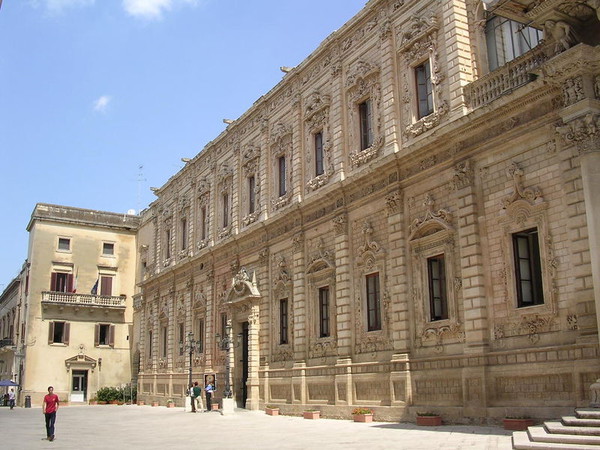
The facade is a majestic display of windows, columns and decorative features. You can also go inside where there is an attractive courtyard.
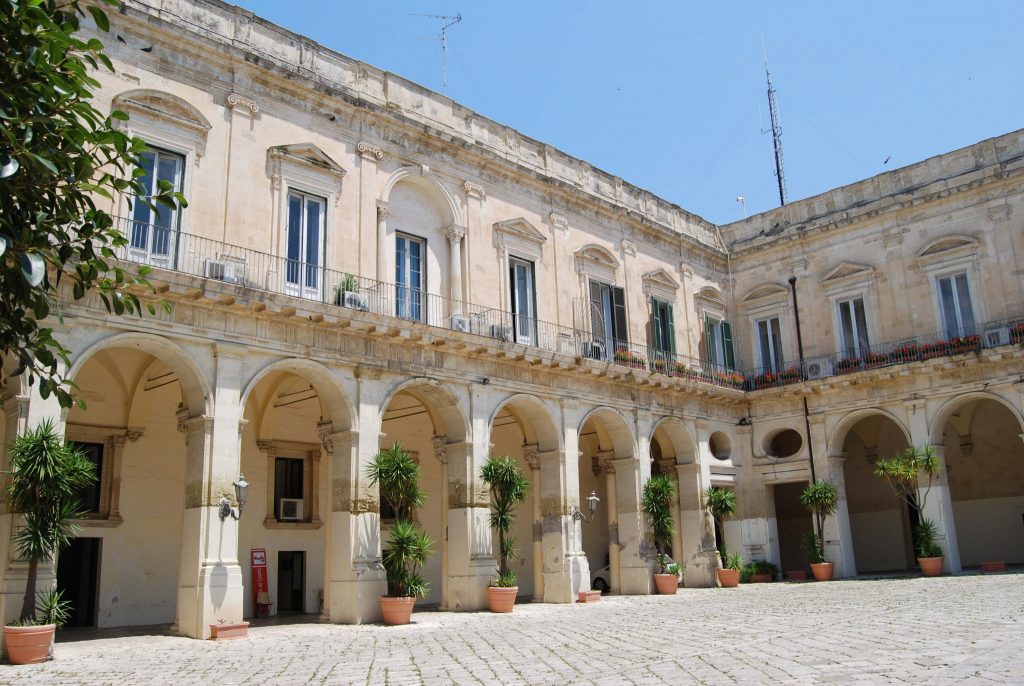
Public Gardens
You can walk though the courtyard of the Palazzo dei Celestini to reach the Public Gardens, with trees and fountains. These can be a welcome relief from the streets of Lecce, which can get pretty hot in summer.
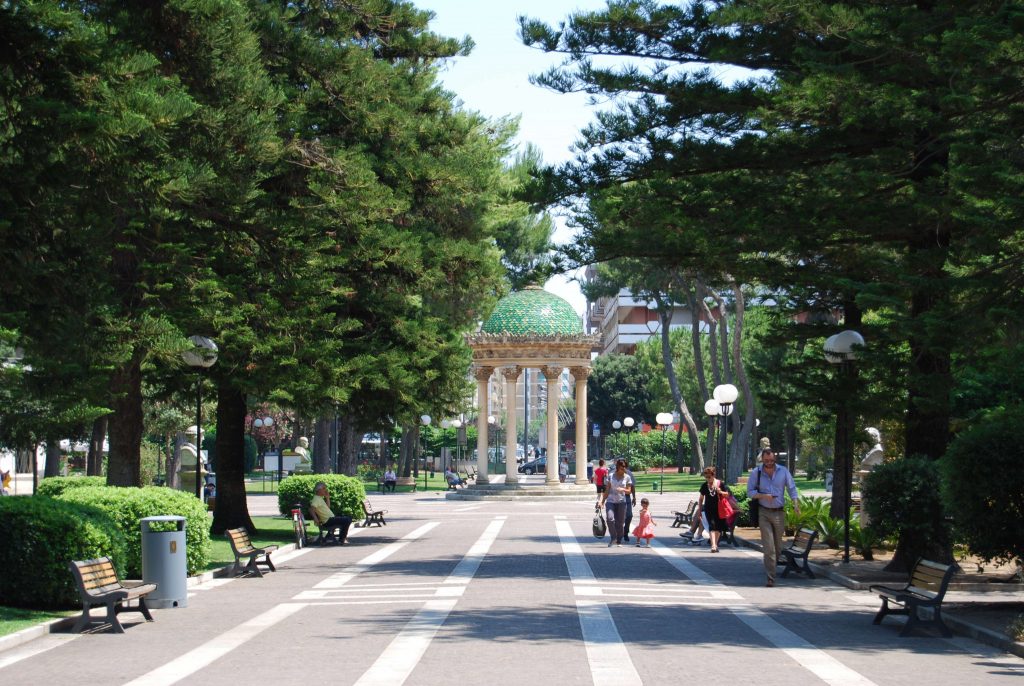
Palazzo Taurino - museum of Jewish life in Lecce
Lecce is a place to wander around and explore casually if you are not a dedicated baroque enthusiast. There are various museums and galleries of course. A new and slightly unusual addition to these is a museum right next to Santa Croce in the Palazzo Taurino, illustrating the Jewish contribution to mediaeval Lecce, a glimpse into life in the city before the baroque period, when Jews were very important in its trading and commercial success. The site is in the basement of an ancient synagogue, with remains of baths fed by the watercourse which runs beneath the city. There are tours in various languages. A short film describes the resettlement camps in this part of Italy in 1945-50, where Jews who survived the Holocaust spent time before moving on (mainly to Israel and America).
